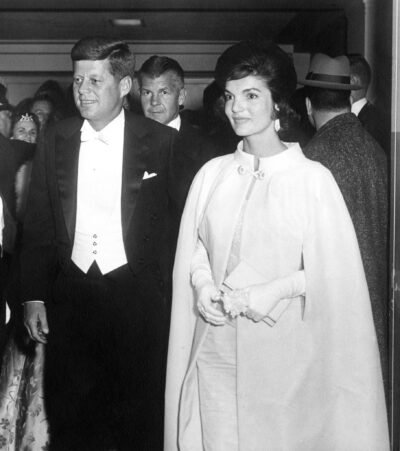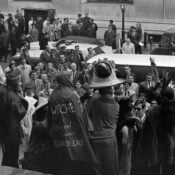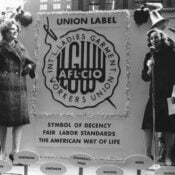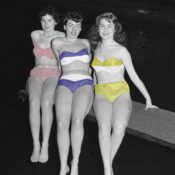Summer brings with it many traditions: Vacation destinations, outdoor activities, and special dishes and cocktails. Fashion and appearance change too, as the increasing temperatures call for looser outfits made of lighter fabrics.
Yet, summer traditions also bring with them rules and regulations. From beach etiquette to the proper conduct at a garden party, dos and don’ts shape our behavior.
One of these rules is the famous admonition that white clothes should only be worn between Memorial Day and Labor Day. If today this rule is not enforced with much rigor, for many years wearing white after Labor Day was not just considered a fashionable “faux pas,” but a mark of bad manners and bad taste.

The custom of wearing light, often white, clothing during the summer goes back to the 19th century, when the lack of air conditioning necessitated other measures to cool down. In a time when appropriate attire mandated layers of fabrics, what you wore had important role in regulating body temperature. Fabrics like linen and silk are more breathable, and white doesn’t absorb heat as quickly as darker colors. White clothes were a practical fashion choice for summer. Together with straw hats and sun umbrellas, they created a more casual look, which was more suitable to a season marked by “a break” from the regular activities of school and work.

Wearing white during the summer had another important function: It was a marker of class and luxury. White fabrics might disguise sweat, but they tend to show dirt far more easily and thus was harder to maintain. Only those who didn’t need to work for a living, or who could avoid walking in filthy streets, could don white outfits without getting them sullied. Indeed, during the 19th century in cities like New York and Chicago — where sewage, horse manure, and constant air pollution were a fixture — it was almost impossible to keep light-colored clothes clean, no matter the season. White colors were thus only worn in the countryside, far away from the bustling commotion of city life, and only by those who could afford to get out.
For the Gilded Age elite, who often decamped to their second homes in Newport and Saratoga Springs during the summer, wearing white clothes served not only as way to distinguish themselves from the working-class, but also from urban life. As they moved their social calendar to resort towns during the summer, they also transformed their wardrobes.

White clothes became associated not only with the countryside but also with leisure sports such as tennis and golf that only the rich could enjoy. In 1877, the London Wimbledon Club made white tennis clothes a requirement to play, and in 1880, the tennis club of The Newport Casino in Rhode Island also mandated white clothing on the court.

When summer drew to a close and the rich returned to the city, their wardrobe also changed as they swapped their flowy white dresses for darker and more formal clothes. When fall came, wearing white was frowned upon; it made it easy to tell who was not well versed in society’s customs.
The New York Stock Exchange went further and initiated a rule banning white or straw hats on the floor after September 15. When in 1894, Labor Day was announced as a federal holiday on the first Monday in September, the date became the official end of the summer. By the early 20th century, the popular tradition of relinquishing white outfits as the weather cooled down became the famous dictum of not wearing white past Labor Day.


Even as the rule calcified in popular culture by the mid-20th century — marking clear boundaries between society “insiders” and “outsiders” — it already showed signs of erosion. With the expansion of the middle class in the 1950s, travelling out of town was no longer seen as an excursion reserved only for the elites, but as a popular pastime for the masses. And with the advent of air conditioning and the improvement of sanitary conditions, wearing white in big cities was no longer the hazard it was in the 19th century. The coming of the counterculture in the 1960s and its challenge to old traditions also contributed to the rule’s demise.
However, old habits die hard, and even today, the association of white clothes with summer and leisure still maintains its power. When Barack Obama appeared dressed in a tan suit to a press conference (even in the middle of August), it stirred a backlash regarding the lack of seriousness the event called for. Recognizing his mistake, Obama referred to the incident in his last press conference in 2017 saying that while he was tempted to wear his tan suit, “Michelle, whose fashion sense is a little better than mine, tells me that’s not appropriate in January.”

With white clothes assuming other meanings in recent years — mostly their political association with women’s suffrage and equality — people now dare to wear them even beyond the summer months. Even authorities on politeness, such as the manners “bible,” Emily Post’s Etiquette, approve the wearing of white throughout the year.
While wearing white clothing has long been a staple summer tradition, another popular one is to refresh yourself with a new wardrobe in anticipation for fall and the new year. With an eye on both sales and the changing weather due to climate change, it is about time perhaps to combine these two customs and to acquire a new white outfit for fall.
Become a Saturday Evening Post member and enjoy unlimited access. Subscribe now




Comments
Thank you Bob for this question, the acceptable period for wearing white was usually Memorial Day to Labor Day, but today anything goes, and you can wear white all year round.
This article definitely answered what I’ve long heard about not wearing while after Labor Day. I figured it went back to the 19th century. I love white shirts in the hot weather, collared or t-shirts because of the cooler temperature when I HAVE to be out in the heat. My other question was always if it wasn’t okay after Labor Day, when was it okay again?
I wear white when I want. Period. No one dictates my fashion. Trends or fads are for those to follow who have little or nothing else to do.